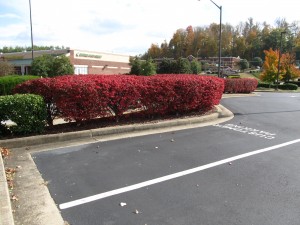Be cautioned from the start that planting dwarf burning bush (Euonymus alata var. compactus) in some states in the U.S. is prohibited. This deciduous shrub is known for its awesome fire engine red fall foliage color (USDA hardiness zones 4 to 8). In shady areas fall leaf color tends to be more pinkish. Fall leaf color is spectacular most years, hence the common name “burning bush”.
This popular shrub grows in average well-drained soil and in full sun to part shade. ‘Compactus’ is not very compact, actually a vigorous grower. It tolerates heavy pruning, including tight hedging. If left unchecked, a single shrub grows mound-like, 10 feet tall and equal or greater in spread.
Small yellowish-green flowers appear in May but most are hidden within the dense foliage. Small red fruit capsules, less than ½ inch in diameter, appear in fall and most are not visible against the crimson red foliage.
Corky ridges (called ‘wings”) line the bark, a simple way to identify this shrub in the winter. The wings or ridges are not prominent on ‘Compactus’ and almost non-existent on very dwarf forms. Dwarf cultivars ‘Rudy Haag’ and Little Moses® may grow 3-4 feet tall and 4-5 feet wide in 15-20 years. Flowers of the latter two cultivars produce few, if any, viable seeds and are less of an invasive threat.
This utility shrub has few serious insect or disease problems. Occasionally, it becomes infested with dreaded euonymus scale, which is managed by applying dormant and summer oils (organic option) or any of several contact insecticides.
Dwarf burning bush is utilized as a single specimen or grouped together as hedges, privacy screens, or foundation shrubs.


 Posted in
Posted in 
